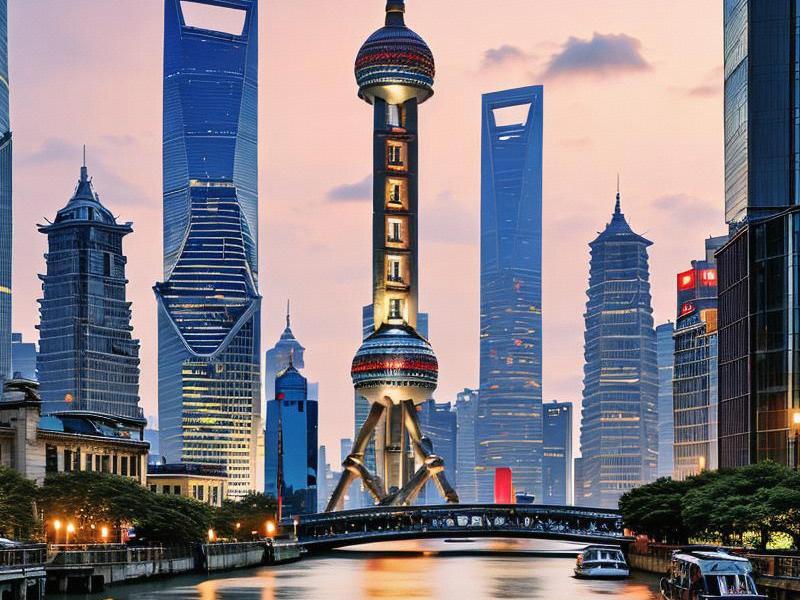This article delves into the dynamic transformation of Shanghai, exploring its blend of modern urban development and rich traditional culture. It highlights the city's iconic skyline, historical landmarks, and the harmonious coexistence of old and new.

Shanghai, a city that has long been a beacon of China's economic and cultural evolution, stands today as a testament to the nation's rapid transformation. Known as the 'Pearl of the Orient,' Shanghai is a metropolis where the past and present coexist in a delicate balance, creating a unique urban tapestry that is both captivating and inspiring.
The city's skyline is a visual symphony of modern architecture, with towering skyscrapers that pierce the heavens, each a symbol of Shanghai's economic prowess and global influence. The iconic Oriental Pearl Tower, with its striking design, has become a symbol of the city itself, while the futuristic Shanghai Tower, the tallest building in China and the second-tallest in the world, showcases the city's ambition and innovation.
Beneath this modern facade lies a rich tapestry of traditional culture. The Bund, a historic waterfront area, is a place where the old meets the new. Here, the colonial-era buildings stand in stark contrast to the gleaming skyscrapers of Pudong across the Huangpu River, creating a visual narrative of Shanghai's history and progress. The Bund is not just a place to admire architecture but also a hub of cultural activity, with museums, art galleries, and theaters that celebrate the city's heritage.
One cannot discuss Shanghai without mentioning the intricate network of its canals and the charming old neighborhoods that line them. The Yu Garden, a classical Chinese garden built in the Ming Dynasty, is a serene oasis in the heart of the city. Its meticulously designed landscapes, ponds, and pavilions offer a glimpse into the traditional aesthetics and philosophy of ancient China. Nearby, the Yuyuan Bazaar is a bustling marketplace that sells everything from traditional handicrafts to modern souvenirs, reflecting the city's vibrant commercial spirit.
阿拉爱上海
Shanghai's culinary scene is another aspect where tradition and modernity converge. The city is renowned for its diverse and sophisticated cuisine, which blends the flavors of Jiangsu and Zhejiang provinces with international influences. From the delicate xiaolongbao (soup dumplings) of Nanxiang to the fiery Sichuan hot pot, Shanghai's food scene is a testament to the city's openness to the world while preserving its culinary roots.
The city's cultural calendar is filled with events that celebrate its heritage and contemporary art scene. The Shanghai International Film Festival, one of the oldest and most prestigious film festivals in Asia, attracts filmmakers and cinephiles from around the globe. The Shanghai Art Fair and various contemporary art exhibitions showcase the works of both local and international artists, highlighting the city's role as a cultural hub.
Shanghai's commitment to sustainability and green development is also noteworthy. The city has invested heavily in eco-friendly infrastructure, including public transportation systems that prioritize electric buses and subways, reducing carbon emissions and improving air quality. Green spaces like Century Park and the Shanghai Botanical Garden provide residents and visitors with tranquil retreats, emphasizing the importance of environmental conservation.
上海龙凤阿拉后花园
Education and innovation are at the heart of Shanghai's development strategy. The city is home to world-class universities and research institutions, such as Fudan University and Tongji University, which are at the forefront of academic research and technological innovation. The Zhangjiang Hi-Tech Park is a hub for high-tech enterprises and startups, fostering a vibrant innovation ecosystem that drives the city's economic growth.
Shanghai's transformation is not without its challenges. The rapid urbanization has led to issues such as housing shortages, traffic congestion, and environmental concerns. However, the city government has implemented various measures to address these challenges, including the development of satellite cities and the promotion of public transportation to reduce reliance on private vehicles.
The people of Shanghai are the lifeblood of the city, embodying its spirit of resilience, adaptability, and entrepreneurialism. The city's cosmopolitan population, with its mix of native Shanghainese and migrants from all over China and the world, contributes to a rich tapestry of cultures, languages, and traditions.
上海龙凤阿拉后花园
Shanghai's future looks promising as it continues to evolve into a global leader in finance, technology, culture, and sustainability. The city's vision for the future includes the development of new districts like the Lujiazui Financial District and the Yangshan Deep Water Port, which will further enhance its status as a global financial hub.
In conclusion, Shanghai's renaissance is a story of transformation and resilience, where the city has successfully blended its rich historical heritage with cutting-edge modernity. It is a city that offers a unique perspective on China's journey towards modernization while preserving its cultural identity. As Shanghai continues to grow and innovate, it remains a beacon of hope and opportunity, inspiring cities around the world to embrace their own paths of development.